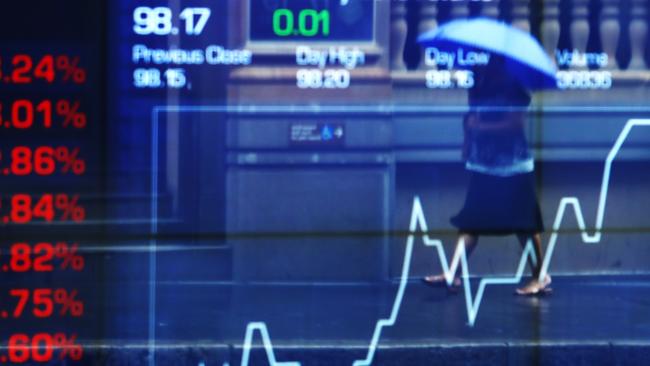Australia’s rebounding sharemarket faces reality check from record profit declines
High-profile analysts are warning of a particularly challenging profit reporting season.

Australia’s rebounding sharemarket faces a reality check from record profit declines and a “dividend recession” in the August reporting season, even as the coronavirus crisis showed signs of stabilising.
After sharply underperforming global markets last month as Victoria’s worsening second wave culminated in a “state of disaster” and stage-four restrictions this week, the S&P/ASX 200 surged 2 per cent on Tuesday and a number of Melbourne-exposed stocks were among the best performers.
But high-profile analysts are warning of a particularly challenging profit reporting season.
UBS Australia quantitative analyst Pieter Stoltz expects earnings per share to fall 21 per cent — as bad as the global financial crisis — while also seeing a 39 per cent plunge in dividends per share.
Reflecting the uncertainty caused by the pandemic, the typical pre-reporting season “confession season” didn’t happen and some 49 of the top 100 lowered or removed guidance since early March.
Perhaps surprisingly, the only sector expected to grow earnings this year has been discretionary retail — driven by booming retail spending due to stimulus measures — while insurance, energy and gaming are expected to offer the weakest earnings growth.
Of course the bigger focus amid record-low interest rates and earnings uncertainty will be whether companies pay dividends and guide on earnings, and whether they need to raise more capital.
Mr Stoltz warns of a “dividend recession”, with over 35 per cent of reporting companies unlikely to pay a dividend, compared to less than 10 per cent of companies that reported this time a year ago.
On a positive note, Mr Stoltz has found 30 ASX-listed companies — including such heavyweights as CSL, Fortescue Metals, Wesfarmers, ResMed, Telstra, Newcrest, Brambles, JB Hi-Fi, APA Group, Ansell, OZ Minerals and Magellan — that are likely to hold or raise their dividends.
But Mr Stoltz sees twice as many companies cutting their dividend by more than a third. That group includes many household names such as Commonwealth Bank, Transurban, Woodside, QBE, Sydney Airport, Scentre, Oil Search, Ramsay Health Care, Qantas, Crown, Cochlear, GPT, Origin, and Lendlease.
“We think companies that can continue to pay, or even grow, their dividends are likely to outperform as investors seek stable sources of income,” he says.
At the same time, the one-year forward price-to-earnings ratio of the Australian market is “looking stretched” versus the risk-free rate (the 10-year government bond yield), according to JPMorgan.
At its current level near 20 times, the PE multiple remains close to a record high near 21 times hit in June.
Moreover, either a negative bond yield or a 20 per cent recovery in aggregate earnings (or some combination thereof) would be needed to restore the inverse relationship between bonds and equities to its “line of best fit”, says JPMorgan Australia head of research, Jason Steed.
“With COVID-19 uncertainty still stalking NSW and Victoria’s more aggressive restrictions only just implemented, we struggle to find grounds for optimism and thus have further scaled up the defensive allocations in our model portfolio,” he said.
“Looking forward, the coming weeks will be subsumed with a results season that will be characterised by record profit declines, writedowns and management teams who are highly unlikely to commit to definitive guidance.”
His regression analysis of the one-year forward PE multiple and bond yields found a clear inverse correlation, with more than half of variations in the PE explained by changes in the bond yield.
But the current combination is a “meaningful outlier” on a par (in the opposite direction) with the September 11, 2001 terrorist attacks and the European debt crisis of mid-2012. “Of course, the ‘E’ (earnings per share) underpinning today’s multiple is not reflective of the market’s earnings,” Mr Steed notes.
“However, per the extrapolation of the relationship we show, there is the need for either a negative 10-year or a 20 per cent recovery in earnings.”
In response to worsening coronavirus trends he has turned more defensive on Australian equities.
His model portfolio is overweight materials, healthcare, communications, utilities and consumer staples, and its biggest underweight is the consumer discretionary sector.
Similarly on Monday, Morgan Stanley Australia’s head of research Chris Nicol warned that profit season looms as a “catalyst for a tradeable correction in the ASX 200”.
“With valuations stretched and still some downward pressure in the earnings pulse, we think the risk to near-term index direction is to the downside,” Mr Nicol said.
“In our view, investors have over-estimated the pace of economic recovery and too quickly capitalised sequential momentum off what was a sudden stop in earnings and activity.”








To join the conversation, please log in. Don't have an account? Register
Join the conversation, you are commenting as Logout